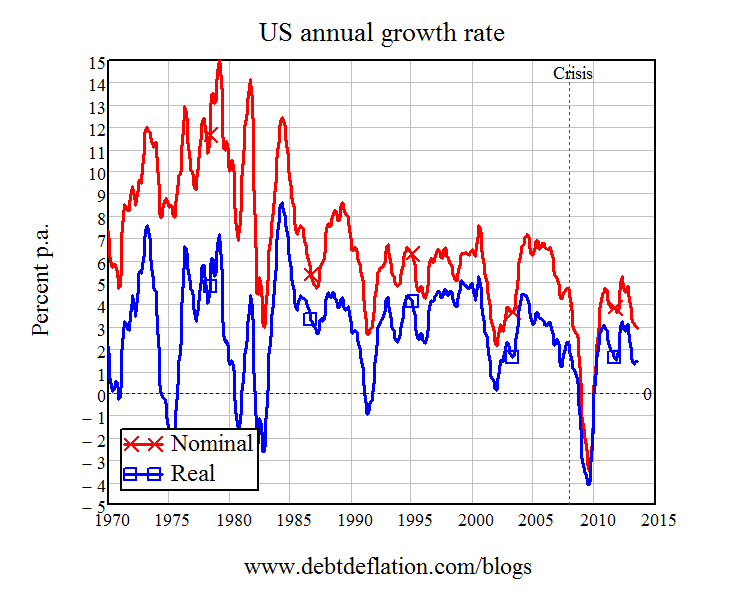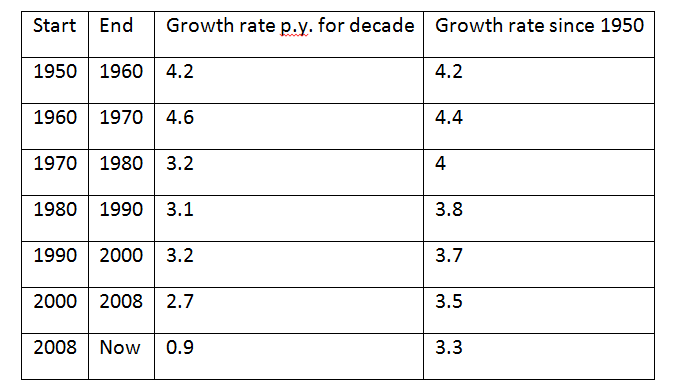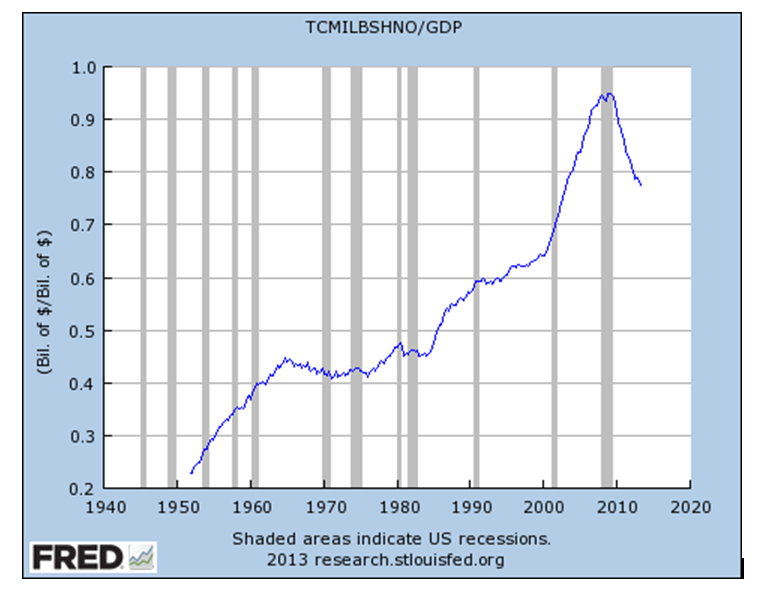End this Depression? Never
Larry Summers’ speech at the IMF has provoked a flurry of responses from New Keynesian economists that imply that Summers has located the “Holy Grail of Macroeconomics” – and that it was a poisoned chalice.
“Secular stagnation”, Summers suggested, was the real explanation for the continuing slump, and it had been with us for long before this crisis began. Its visibility was obscured by the subprime bubble, but once that burst, it was evident.
So the crisis itself was a sideshow. The real story is about inadequate private sector demand, which may have existed for decades. Generating adequate demand in the future may require a permanent stimulus from the government – meaning both the Congress and the Fed.
What could be causing the secular stagnation – if it exists? Krugman noted a couple of factors: a slowdown in population growth (which is obviously happening: see Figure 1); and “a Bob Gordon-esque decline in innovation” (which is more conjectural).
Figure 1: Population growth rates are slowing

So is a secular trend to lower growth the reason for the continuing stagnation, six years after the crisis began? And is Summers now the Messiah?
Reading Krugman or Miles Kimball, you’d think so on both counts. Kimball headlines his coverage with “Larry Summers just confirmed that he is still a heavyweight on economic policy”, while Krugman states that while he’s been thinking on the same lines, “Larry’s formulation is much clearer and more forceful, and altogether better, than anything I’ve done. Curse you, Red Baron Larry Summers!”
On the issue itself, you’d also think that suddenly the lightbulb has switched on as well, after years in the darkness before and after the crisis. Though Summers’ thesis has its critics (such as Stephen Williamson), there’s a chorus of New Keynesian support for the “secular stagnation” argument, which implies it will soon become the conventional explanation for the persistence of this slump long after the initial financial crisis has passed.
Krugman’s change of tune here is representative. His most recent book-length foray into what caused the crisis – and what policy would get us out of it – was entitled End This Depression Now!. The title screamed that this crisis could be ended “in the blink of an eye”, while the text argued that all it would take is a sufficiently large fiscal stimulus to help us escape the “zero lower bound”. Krugman wrote:
“The sources of our suffering are relatively trivial in the scheme of things, and could be fixed quickly and fairly easily if enough people in positions of power understood the realities.
“One main theme of this book has been that in a deeply depressed economy, in which the interest rates that the monetary authorities can control are near zero, we need more, not less, government spending. A burst of federal spending is what ended the Great Depression, and we desperately need something similar today."
Post-Summers, Krugman is suggesting that a short, sharp burst of government spending will not be enough to restore “the old normal”. Instead, to achieve pre-crisis rates of growth in future – and pre-crisis levels of unemployment – we may need permanent government deficits, and permanent Federal Reserve spiking of the asset market punch via QE and the like. Not only that, but past apparent growth successes – such as The Period Previously Known as The Great Moderation – may simply have been above-stagnation rates of growth motivated by bubbles:
Krugman asks: “So how can you reconcile repeated bubbles with an economy showing no sign of inflationary pressures? Summers’ answer is that we may be an economy that needs bubbles just to achieve something near full employment – that in the absence of bubbles the economy has a negative natural rate of interest. And this hasn’t just been true since the 2008 financial crisis; it has arguably been true, although perhaps with increasing severity, since the 1980s.”
This argument elevates the “zero lower bound” from being merely an explanation for the Great Recession to a General Theory of macroeconomics: if the zero lower bound is a permanent state of affairs given secular stagnation, then permanent government stimulus and permanent bubbles may be needed to overcome it.
Or, as Krugman puts it: “One way to get there would be to reconstruct our whole monetary system – say, eliminate paper money and pay negative interest rates on deposits. Another way would be to take advantage of the next boom – whether it’s a bubble or driven by expansionary fiscal policy – to push inflation substantially higher, and keep it there. Or maybe, possibly, we could go the Krugman 1998/Abe 2013 route of pushing up inflation through the sheer power of self-fulfilling expectations.”
So is secular stagnation the answer to the puzzle of why the economy hasn’t recovered post the crisis? And is permanently blowing bubbles (as well as permanent fiscal deficits) the solution?
Figure 2: A secular slowdown in growth caused by a secular trend to stagnation
Firstly, there is evidence for a slowdown in the rate of economic growth over time, as well as its precipitous fall during and after the crisis. The growth rate was as high as 4.4 per cent per annum on average from 1950-1970, but fell to about 3.2 per cent per annum from 1970-2000 and was only 2.7 per cent in the noughties prior to the crisis, after which it has plunged to an average of just 0.9 per cent per annum (see Table 1).
Table 1: US Real growth rates per annum by decade
The sustained growth rate of the US economy is lower now than it was in the 1950s-1970s, and the causes go well beyond the undoubted demographic trend that Krugman nominates and the rather more dubious suggestion of a decline in innovation.
Firstly, the corporate transfer of production from the US (and Europe) to the third world over the last 40 years has substituted low-wage, low-consumption third world workers for high-wage, high-consumption Americans and Europeans. This benefited Western and third-world capitalists, but at the expense of reducing global demand. The free trade that conventional economists champion has in fact help replace the ‘beggar the neighbour’ politics of the protectionist past with ‘beggar thy working class’ politics today.
Secondly, there’s the impact of rising inequality on consumption. Inequality is at unprecedented levels today, possibly the highest it has ever been in human history, according to James K Galbraith, the global authority on this topic. That inequality leads to huge demand for luxury yachts, but diminished demand for almost everything else. Demand in the aggregate could fall.
And there’s a third factor that Krugman alludes to in his post, which I suspect might start to turn up in future in his explanation of the crisis: the rise in household debt during 1980-2010. With the notable exception of Robert Shiller, this wasn’t foreseen by mainstream economists in neither the freshwater nor saltwater sects.
Figure 3, sourced from the St Louis Fed’s excellent FRED database, and taken from Krugman’s post, outlines this trend.
Figure 3: Ratio of household debt to GDP
Now, as any well-trained economist knows, it’s a matter of simple logic that what happens to private debt is irrelevant to macroeconomics most of the time because “debt is one person's liability, but another person's asset”.
However, private debt does matter during a liquidity trap, because then lenders might get worried about the capacity of borrowers to repay and impose a limit on debt that borrowers have already exceeded, forcing borrowers to repay their debt and spend less. To maintain the full-employment equilibrium, people who were once lenders have to spend more to compensate for the fall in spending by now debt-constrained borrowers.
But lenders are patient people, who by definition have a lower rate-of-time preference than borrowers, who are impatient people.
In the New York Times, Krugman wrote: “Now, if people are borrowing, other people must be lending. What induced the necessary lending? Higher real interest rates, which encouraged “patient” economic agents to spend less than their incomes while the impatient spent more.”
The problem in a liquidity trap is that rates can’t go low enough to encourage patient agents to spend enough to compensate for the decline in spending by now debt-constrained impatient agents.
Krugman elaborates: “You might think that the process would be symmetric: debtors pay down their debt, while creditors are correspondingly induced to spend more by low real interest rates. And it would be symmetric if the shock were small enough. In fact, however, the deleveraging shock has been so large that we’re hard up against the zero lower bound; interest rates can’t go low enough. And so we have a persistent excess of desired saving over desired investment, which is to say persistently inadequate demand, which is to say a depression.
Summers’ thesis now implies that the US economy has in fact been in a liquidity trap for decades, possibly “since the 1980s”, Krugman contends.
This suggests a hypothesis that I wouldn’t at all be surprised to see tested in the pages of the New York Times. Firstly, America hasn’t always been suffering secular stagnation, nor has it always been in a liquidity trap. Secondly, sound economics tells us that only when the economy is in one does private debt matter macroeconomically. So it should be possible to work out how long the liquidity trap has applied, by working out when the level (or rate of change, or some other measure) of private debt correlated with macroeconomic variables (say the level, or rate of change of unemployment), and when it didn’t.
I await the test of this hypothesis. I might even check it out myself.
Steve Keen is author of Debunking Economics and the blog Debtwatch and developer of the Minsky software program.
















